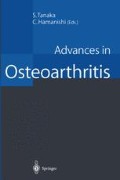Summary
Magnetic resonance imaging (MRI) provides a unique opportunity to explore osteoarthritis in ways that were unimaginable in the past. While MRI has not replaced radiography in clinical practice, it has many advantages for exploring the cause of pain and dysfunction in diarthroidal joints, and for following the course of therapy. MRI offers three principal advantages over conventional radiography for evaluating the health of joints: a multiplanar tomographic viewing perspective, unparalleled soft tissue contrast, and digital image format. MRI techniques that have been developed harness different tissue characteristics in cartilage and surrounding structures to allow examination of all components of the joint simultaneously. This capability for whole-organ imaging of the joint is unprecedented in medical imaging and cogent to the current view of osteoarthritis as a disease of organ failure. MRI is thus a valuable tool with unprecedented and unparalleled capabilities for evaluating osteoarthritis and its progress and provides a unique opportunity for exploration of this highly prevalent and debilitating disease.
Access this chapter
Tax calculation will be finalised at checkout
Purchases are for personal use only
Preview
Unable to display preview. Download preview PDF.
References
Budinger T, Lauterbur P (1984) Nuclear magnetic resonance technology for medical studies. Science 226:288–298
Young S (1988) Magnetic resonance imaging: basic principles. Raven, New York
König S, Brown R (1984) Determinants of proton relaxation in tissue. Magn Reson Imaging 1:437–449
Peterfy C (1997) Imaging techniques. In: Klippel J, Dieppe P (eds) Rheumatology, 2nd edn. Mosby, Philadelphia, pp 14.1–14.18
Palmer WE, Rosenthal DI, Shoenberg OI, et al (1995) Quantification of inflammation in the wrist with gadolinium-enhanced MR imaging and PET with 2-[F-18]-fluoro-2-deoxy-D-glucose. Radiology 196:645–655
Gindele A, Peterfy CG, Häckl F, et al (1996) MR imaging evaluation of arthritis in the wrist using a low-field, dedicated extremity system (Artoscan™). Presented at the 96th annual meeting of the American Roentgen Ray Society, May, 1996, San Diego, CA
Mow VC, Ratcliffe A, Poole AR (1992) Cartilage and diarthroidial joints as paradigms for hierarchical materials and structures. Biomaterials 13:67–97
Peterfy CG, Genant HK (1996) Emerging applications of magnetic resonance imaging for evaluating the articular cartilage. Radiol Clin North Am 34:195–213
Xia Y, Farquhar T, Burton-Wurster N, Lust G (1997) Origin of cartilage laminae in MRI. J Magn Reson Imaging 7:887–894
Xia Y, Farquhar T, Burton-Wurster N, Ray E, Jelinski LW (1994) Diffusion and relaxation mapping of cartilage-bone plugs and excised disks using microscopic magnetic resonance imaging. Magn Reson Med 31:273–282
Burstein D, Gray ML, Hartman AL, Gipe R, Foy BD (1993) Diffusion of small solutes in cartilage as measured by nuclear magnetic resonance (NMR) spectroscopy and imaging. J Orthop Res 11:465–478
Woolf SD, Chesnick S, Frank JA, Lim KO, Balaban RS (1991) Magnetization transfer contrast: MR imaging of the knee. Radiology 179:623–628
Peterfy CG, Majumdar S, Lang P, van Dijke CF, Sack K, Genant H (1994) MR imaging of the arthritic knee: improved discrimination of cartilage, synovium and effusion with pulsed saturation transfer and fat-suppressed T1-weighted sequences. Radiology 191:413–419
Peterfy CG, van Dijke CF, Janzen DL, et al (1994) Quantification of articular cartilage in the knee by pulsed saturation transfer and fat-suppressed MRI: optimization and validation. Radiology 192:485–491
Rose PM, Demlow TA, Szumowski J, Quinn SF (1994) Chondromalacia patellae: fat-suppressed MR imaging. Radiology 193:437–440
Dardizinski B, Mosher T, Li S, Van Slyke M, Smith M (1997) Spatial variation of T2 in human articular cartilage. Radiology 205:546–550
Disler D (1997) Fat-suppressed three-dimensional spoiled gradient-recalled MR imaging: assessment of articular and physeal hyaline cartilage. A J R 169:1117–1123
Disler DG, McCauley TR, Kelman CG, et al (1996) Fat-suppressed three-dimensional spoiled gradient-echo MR imaging of hyaline cartilage defects in the knee: comparison with standard MR imaging and arthroscopy. A J R 167:127–132
Disler DG, McCauley TR, Wirth CR, Fuchs MC (1995) Detection of knee hyaline articular cartilage defects using fat-suppressed three-dimensional spoiled gradient-echo MR imaging: comparison with standard MR imaging and correlation with arthroscopy. A J R 165:377–382
Recht MP, Pirraino DW, Paletta GA, Schils JP, Belhobek GH (1996) Accuracy of fat-suppressed three-dimensional spoiled gradient-echo FLASH MR imaging in the detection of patellofemoral articular cartilage abnormalities. Radiology 198:209–212
Chandnani VP, Ho C, Chu P, Trudell P, Resnick D (1991) Knee hyaline cartilage evaluated with MR imaging: a cadaveric study involving multiple imaging sequences and intraarticular injection of gadolinium and saline solution. Radiology 178:557–561
Dupuy DE, Spillane R, Rosol M, et al (1996) Quantification of articular cartilage in the knee with three-dimensional MR imaging. Acad Radiol 3:919–924
Pilch L, Stewart C, Gordon D, et al (1994) Assessment of cartilage volume in the femorotibial joint with magnetic resonance imaging and 3D computer reconstruction J Rheumatol 21:2307–2321
Eckstein F, Sitteck H, Gavazzenia A, Milz S, Putz R, Reiser M (1995) Assessment of articular cartilage volume and thickness with magnetic resonance imaging (MRI). Trans Orthop Res Soc 20:194
Ateshian GA, Kwak SD, Soslowsky LJ, Mow VC (1994) A stereophotogrammetric method for determining in situ contact areas in diarthroidial joints, and a comparison with other methods. J Biomech 27:111–124
Peterfy C, Howard D (1997) Imaging the patellofemoral joint: current status and future directions. Am J Knee Surg 10:110–120
Author information
Authors and Affiliations
Editor information
Editors and Affiliations
Rights and permissions
Copyright information
© 1999 Springer-Verlag Tokyo
About this paper
Cite this paper
Peterfy, C.G. (1999). Applications of MRI for Evaluating Osteoarthritis. In: Tanaka, S., Hamanishi, C. (eds) Advances in Osteoarthritis. Springer, Tokyo. https://doi.org/10.1007/978-4-431-68497-8_6
Download citation
DOI: https://doi.org/10.1007/978-4-431-68497-8_6
Publisher Name: Springer, Tokyo
Print ISBN: 978-4-431-68499-2
Online ISBN: 978-4-431-68497-8
eBook Packages: Springer Book Archive

